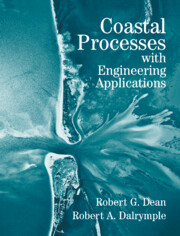Book contents
- Frontmatter
- Contents
- Preface
- Acknowledgments
- PART ONE INTRODUCTION TO COASTAL PROCESSES
- PART TWO HYDRODYNAMICS OF THE COASTAL ZONE
- PART THREE COASTAL RESPONSE
- 6 Field Measurement Techniques and Analysis
- 7 Equilibrium Beach Profiles
- 8 Sediment Transport
- 9 Miscellaneous Coastal Features
- 10 Modeling of Beaches and Shorelines
- PART FOUR SHORELINE MODIFICATION AND ANALYSIS
- Author Index
- Subject Index
6 - Field Measurement Techniques and Analysis
Published online by Cambridge University Press: 29 May 2010
- Frontmatter
- Contents
- Preface
- Acknowledgments
- PART ONE INTRODUCTION TO COASTAL PROCESSES
- PART TWO HYDRODYNAMICS OF THE COASTAL ZONE
- PART THREE COASTAL RESPONSE
- 6 Field Measurement Techniques and Analysis
- 7 Equilibrium Beach Profiles
- 8 Sediment Transport
- 9 Miscellaneous Coastal Features
- 10 Modeling of Beaches and Shorelines
- PART FOUR SHORELINE MODIFICATION AND ANALYSIS
- Author Index
- Subject Index
Summary
Some of the most ambitious and daring field programs occurred during World War II with the University of California at Berkeley's field studies (directed by M.P. O'Brien) of the beaches of northern California, Oregon, and Washington. The studies were intended to examine the nature of beaches and waves to provide information for amphibious landings on enemy beaches. The field surveys consisted of beach profiles made using military amphibious vehicles (DUKW) in surf sometimes exceeding 6 m – so high that sometimes the 10-m-long vehicles would surf the waves. The measurements were made by lead line casts along profiles separated by about 300 m. Triangulation of the DUKW by a transit operator located onshore provided the position information. Fortunately, no one was killed during these studies! (A further description of these studies can be found in Bascom 1980.)
INTRODUCTION
The elevations– and contours of a shoreline are a response to the forcing of waves, winds, and currents and depend on the supply of sediment to the beach. By measuring the dimensions of a beach repeatedly, the amounts of erosion or accretion can be determined over the period of the surveys as well as some indications of where the material may be going.
This chapter will review methods of measuring the beach and present several tools for determining beach changes such as the empirical orthogonal eigenfunction method, which is a convenient method to resolve the nature of the changes in a beach profile, and the sand budget analysis.
- Type
- Chapter
- Information
- Coastal Processes with Engineering Applications , pp. 133 - 161Publisher: Cambridge University PressPrint publication year: 2001



